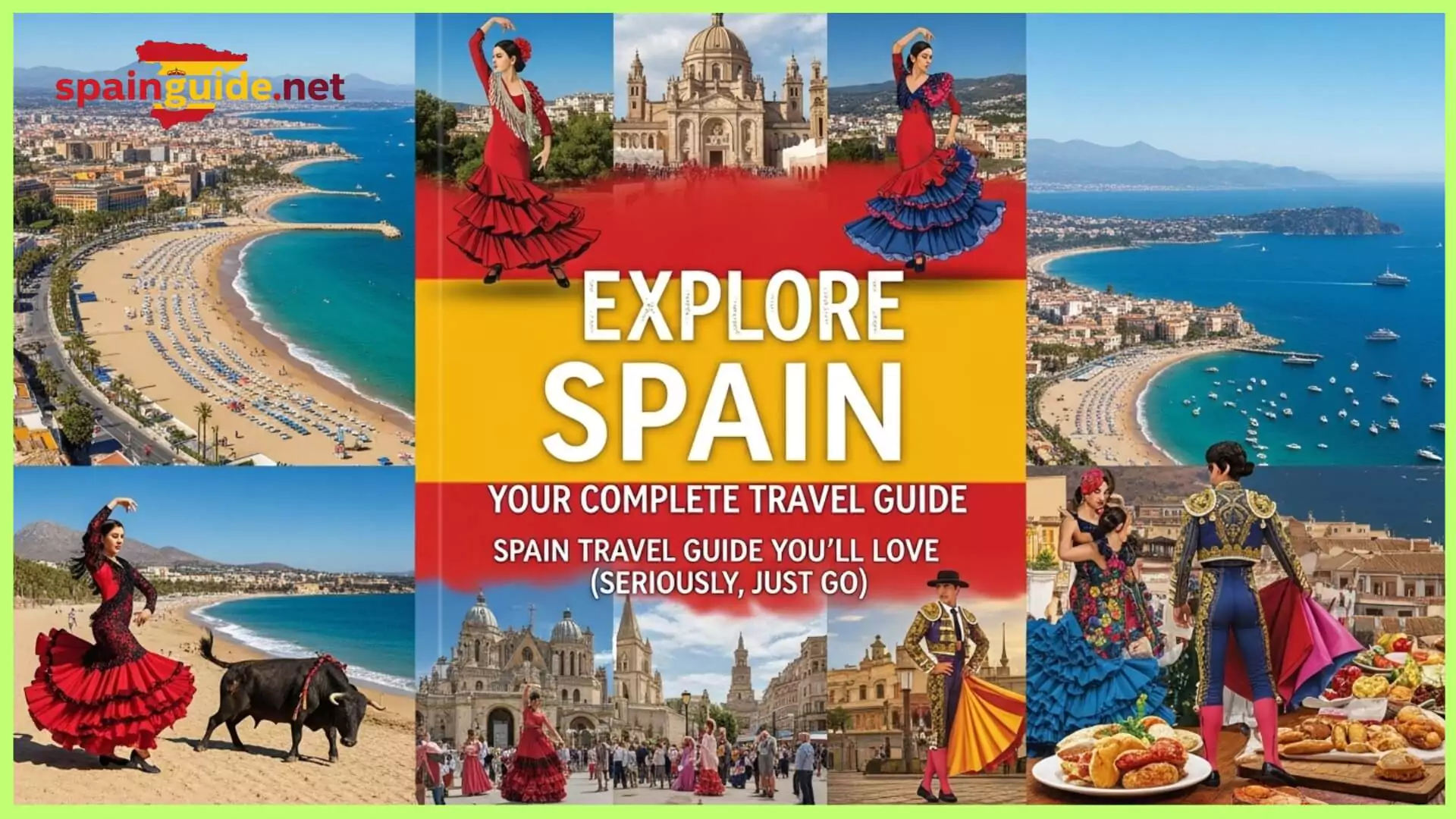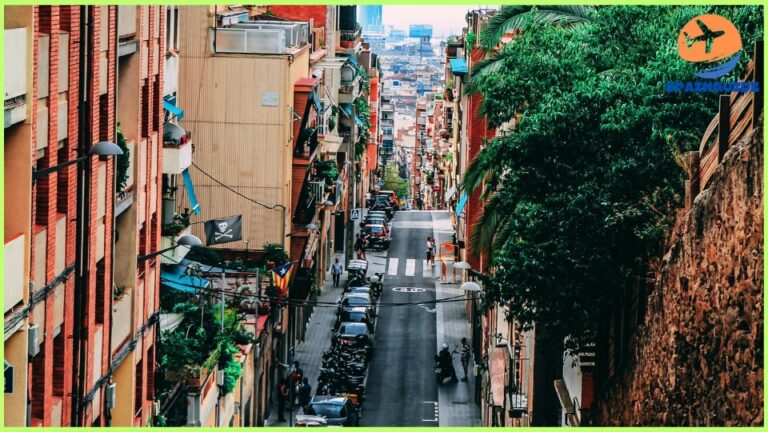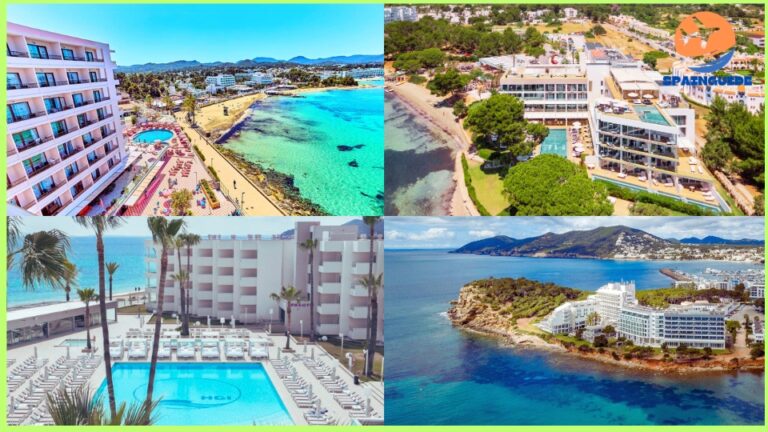Alright, let’s just be honest – Spain is that friend that’s flawless at everything, and still manages to be a great person to connect with. This country has a stunning mix of architecture, mouthwatering food, unbelievable beaches, and sleepless cities. When you go to Spain, it’s not just a journey; you’ll have already started googling flights back home before you leave.
I’ve put together this guide to help you navigate Spain like you actually know what you’re doing (even if you’re secretly panicking about the language barrier – spoiler alert: you’ll be fine).
Why Spain is the Perfect Travel Destination for Your Next Trip
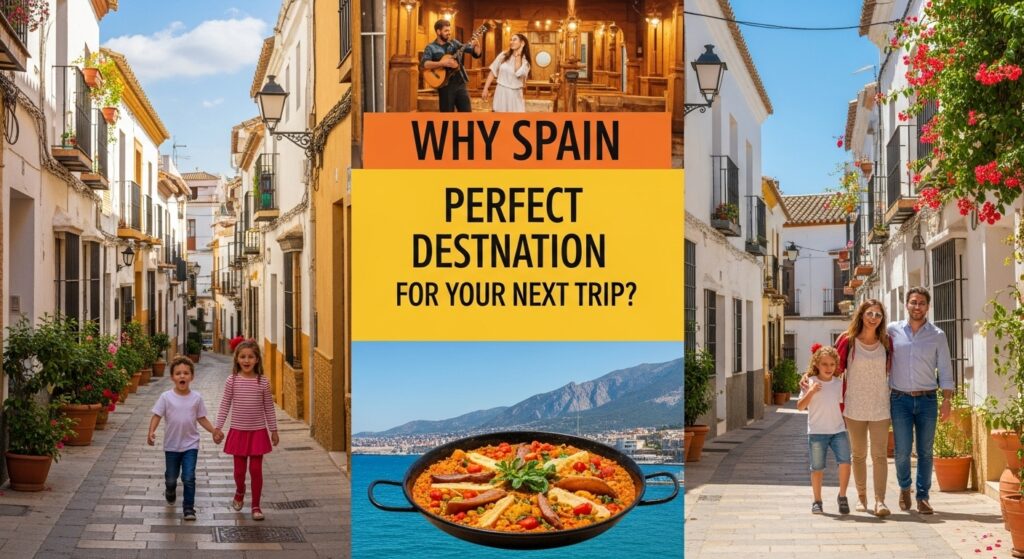
I could sell you a bunch of great reasons to go, but truthfully? Spain is one of those places that just fits. You know how some
First off, the history here is absolutely insane. You can literally walk through Toledo’s streets and see where Christians, Muslims, and Jews all left their mark – it’s like a living, breathing history lesson that doesn’t suck. Then you’ve got Roman stuff in Segovia, prehistoric cave art, and those mind-blowing Moorish palaces in Granada. It’s basically a time machine, but with better food.
Speaking of food – oh my god, the food. Sure, everyone knows about paella and tapas, but experiencing the real deal in Valencia or hopping between pintxos bars in San Sebastián? That’s next-level stuff. And don’t even get me started on jamón ibérico – it’s like regular ham went to university and got a PhD in deliciousness.
The landscapes here are crazy diverse too. You want beaches? They’ve got Costa del Sol’s golden stretches. Mountains? The Picos de Europa will blow your mind. Rolling countryside? Andalusia’s olive groves have entered the chat. Each region has its own personality and Spain tourist attractions that’ll make your Instagram followers seriously jealous.
And the festivals? Spain doesn’t mess around when it comes to celebrating. La Tomatina is basically the world’s biggest food fight, and trust me, it’s as ridiculous and amazing as it sounds. Plus, Spanish cities have this incredible energy – they’re always buzzing with life, and the nightlife culture here will make you question why you ever went to bed before 2 AM back home.
When Should You Actually Go?
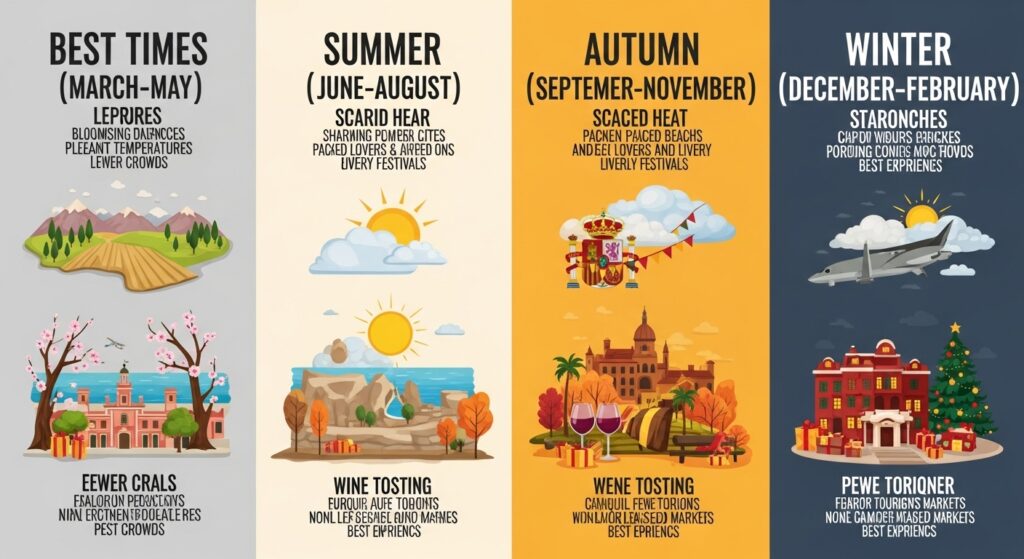
The best time to visit Spain really depends on what you’re after and how much you want to spend, but I’ll break it down for you.
Spring (March-May) is honestly perfect. Like a warm hug from the weather, around 59-72 degrees (F), perfect to walk around the cities without sweating through your shirt. The Easter processions are in Andalusia are wonderfully spectacular (and a bit emotional), the crowds are mildly busy, and the hotels cause very little heartache for your wallet. It’s like Spain’s perfect middle ground.
Summer (June-August) is beach paradise time. Coastal areas hit that perfect 77-86°F sweet spot, but heads up – Madrid and Seville turn into actual ovens (we’re talking 95°F+). The upside? Festival season is in full swing, and the energy is infectious. Just be prepared to pay summer prices for everything.
Fall (September-November) is seriously underrated. September is especially brilliant – still warm, way fewer crowds, and it’s harvest season in wine country (hello, wine tastings!). Spain weather by month in fall ranges from lovely 68-77°F early on to cozy 54-64°F later. Plus, everything costs less.
Winter (December-February) transforms Spain into something completely different. The coast stays mild, mountain regions become ski destinations, and cities get this intimate, cozy vibe that’s perfect for museum hopping. Best hotel deals of the year, smallest crowds, though some beach spots might be pretty quiet.
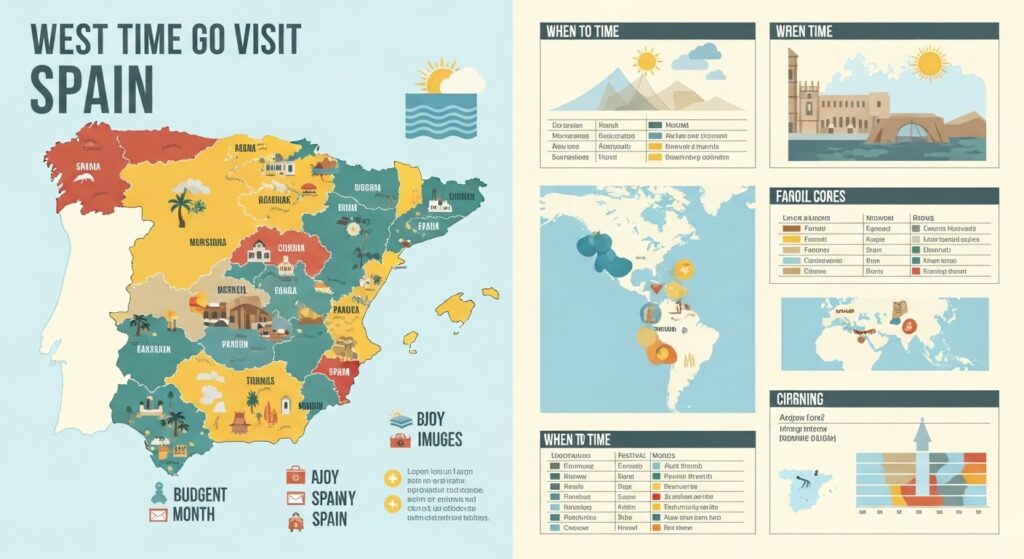
Pro tip: Northern Spain gets more rain but milder summers, while the south is sunshine central but can be brutally hot. Coast = consistent temps, inland = drama queen weather.
The Must-Hit Spanish Cities
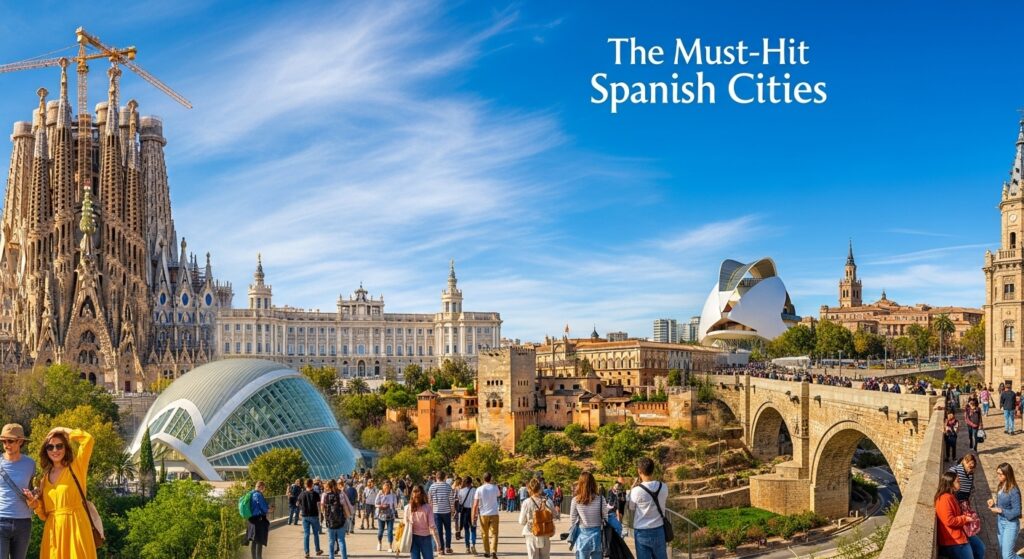
These top cities in Spain each have their own vibe, and honestly, they’re all worth your time. These best places to visit in Spain will give you completely different experiences.
Barcelona is like that artsy friend who somehow makes weird fashion choices look amazing. Gaudí’s buildings (especially the Sagrada Família and Park Güell) are so bizarre and beautiful they’ll mess with your head in the best way. You’ve got beaches right in the city, the Gothic Quarter is perfect for getting delightfully lost, and the nightlife goes hard from beachfront bars to rooftop cocktail spots.
Madrid is the sophisticated older sister to Spain. World-class art will be found in this city! The Prado, Reina Sofía, Thyssen-Bornemisza museums will keep you occupied for days. Retiro Park is the best people-watching ever and THOSE TAPAS are so good. Even better – you’re in a central location with day-trip possibilities to Toledo or Segovia.
Seville is pure Andalusian magic. Think flamenco guitar drifting from hidden bars, orange trees lining the streets, and architecture that’ll make you question reality. The Alcázar palace is stunning, the cathedral is massive (Columbus is buried there!), and the tapas bars tucked into tiny plazas are exactly what you picture when you think “authentic Spain.”
Granada will ruin every other palace for you once you see the Alhambra. Seriously, this place is Islamic architecture at its absolute peak. The Albaicín neighborhood has these incredible viewpoints looking across at the Alhambra, and the Sacromonte caves still keep traditional flamenco culture alive. Plus, it’s right near the mountains, so the views are insane.
Valencia is having a serious moment right now. It’s where paella was actually invented (not just some tourist version), and the City of Arts and Sciences looks like it’s from the future. Great beaches, incredible festivals (Las Fallas is wild), and it’s got this perfect mix of old and new.
San Sebastián is basically food heaven on earth. More Michelin stars per person than anywhere except Paris, pintxos culture that turns every meal into a bar crawl, and it sits on this gorgeous bay surrounded by mountains. It’s like someone designed the perfect food lover’s city.
What You Absolutely Have to Eat and Drink
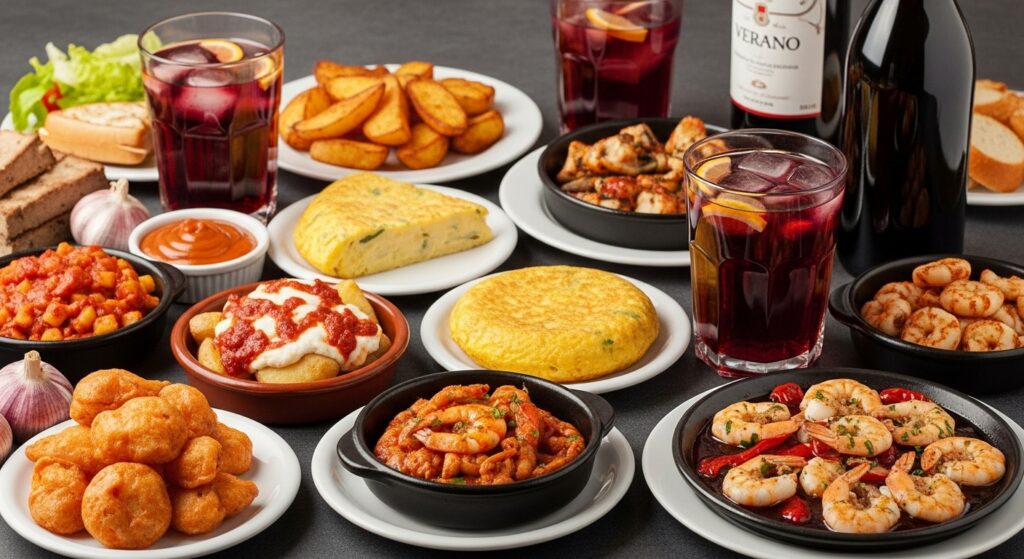
Spanish food is so much more than what you think you know, and this Spanish food guide will help you figure out what to eat in Spain without looking like a total tourist.
Paella is Valencia’s baby, and they’re pretty serious about it. Real Valencian paella has rabbit, chicken, beans, and saffron-soaked rice. Seafood versions are amazing too, but mixing meat and seafood? That’s fighting words in Valencia.
Tapas isn’t just food, it’s a whole social experience. You’ve got your classics like patatas bravas (crispy potatoes with spicy sauce that’ll make you sweat), croquetas (basically fried balls of creamy heaven), and tortilla española (the potato omelet that somehow makes eggs and potatoes taste incredible). Each region does its own thing – Andalusia’s fried fish, Basque pintxos, Galician octopus.
Jamón is Spain’s crown jewel. Jamón serrano is great, but jamón ibérico is where things get serious. The top tier jamón ibérico de bellota comes from pigs that basically live their best life eating acorns, and the result literally melts in your mouth. It’s expensive, but trust me, it’s worth every euro.
Churros and hot chocolate for dipping is the quintessential Spanish comfort food. Madrid’s Chocolatería San Ginés has been serving churros 24/7 since 1894 – that’s some serious dedication to fried dough.
Each region has its own specialties that’ll surprise you. Catalonia’s got butifarra sausages and pan con tomate, Galicia specializes in seafood that’ll spoil you forever, Andalusia’s gazpacho is perfect when it’s hot, and Basque cuisine is basically Spanish fine dining.
Sangria is mundane but enjoyable – locals only really drink sangria when they are celebrating an occasion. Cava is Spain’s equivalent of champagne and so much better value. Rioja wines, made from the Tempranillo grape, have notoriety for a reason as they produce incredible reds that pair beautifully with Spanish cuisine.
Spanish drinking culture is all about socializing and taking your time. Wine with meals, afternoon vermút breaks, and each region has its thing – Galicia’s crisp Albariño, Andalusia’s sherry, Basque txakoli.
Fitting In Like a Local (Sort Of)
Understanding Spanish culture will seriously upgrade your experience and help you connect with locals instead of just taking photos of them. These Spain travel tips and Spanish etiquette for tourists will keep you from looking like a deer in headlights.
Siesta culture is real but not what you think. Yeah, lots of businesses still close 2-5 PM (especially in smaller towns), but it’s more about family lunch time than napping. This is why dinner doesn’t start until 9 or 10 PM – embrace it instead of fighting it.
If you’re used to eating earlier, its going to take some getting used to at first, but eventually you will fall into the rhythm, so just roll with it. Lunch is usually served from 2pm-4pm, and dinners usually don’t start until at least 9pm. In fact, some restaurants may not open until 8pm. When you’ve exhausted all options and don’t have time to coordinate, just find someplace with tapas to carry you through.
Greeting customs involve more physical contact than you might expect. Friends do the two-kiss thing (start left), business is handshakes. Stick with formal “usted” until someone tells you to use “tú” – it’s like Spanish politeness 101.
Dress codes lean smarter than you might pack. Shorts and flip-flops are fine at the beach but not in city centers or restaurants. Spanish people generally dress up more than tourists, so stepping up your game helps you blend in.
Tipping isn’t like America. Round up taxi fares, leave small change at bars. Restaurants appreciate 5-10% for good service but it’s not required. Hotel staff like small tips for great service, but don’t feel obligated for basic stuff.
Safety is generally not a big concern – Spain’s pretty safe. The main thing is pickpockets in touristy areas and on public transport. Keep your valuables secure, don’t flash expensive stuff, and stay aware in crowds.
Spanish people really appreciate when you try speaking Spanish, even if you butcher it. Learn “por favor,” “gracias,” and “disculpe” – it goes a long way.
Getting Around Without Losing Your Mind
Getting around Spain is actually pretty straightforward, and this Spain transportation guide will help you figure out the best options.
Trains (Renfe) are your friend for long distances. The high-speed AVE trains are incredible – Madrid to Barcelona in 2.5 hours, Madrid to Seville in 2.5 hours. Book in advance for better prices, and get flexible tickets if your plans might change.
Flights make sense for longer hauls or when you’re short on time. Vueling, Iberia, and Ryanair connect everything, and sometimes flying Madrid to Bilbao or Barcelona to Seville just makes more sense than the train alternatives.
Buses represent your budget traveling option. ALSA operates most routes, and connects markets not reached by train. They take longer, but have lower cost. You can even save a night’s hotel fees by travelling overnight, if you can sleep sitting up.
Renting a car gives you freedom, especially for coastal drives or exploring rural areas. Just know that highways have tolls, GPS is essential, and parking in city centers ranges from difficult to nightmarish.
Subway systems in big cities are a real relief. Madrid’s metro gets you everywhere, Barcelona has a metro, a bus system, and trams. Valencia, Seville, and Bilbao have modern systems as well.
Travel passes save money if you’re using public transport a lot. Madrid’s Tourist Travel Pass, Barcelona’s Hola BCN! card – they usually pay for themselves after 2-3 days.
Honestly, walking is one of the best ways to experience Spanish cities. Most historic centers pack attractions into walkable areas, and many cities have bike-sharing programs now.
Sample Itineraries That Actually Work
These Spain travel itinerary ideas will help you make the most of your time without burning out. Each one’s designed for real people with real energy levels.
7 Days: The Greatest Hits
Days 1-2: Madrid – Hit the big museums (Prado, Reina Sofía, Thyssen), wander Retiro Park, do a proper tapas crawl in La Latina, maybe day-trip to Toledo if you’re feeling ambitious.
Days 3-4: Barcelona – Take the high-speed train (so smooth!). Sagrada Família will blow your mind, get lost in the Gothic Quarter, stroll Las Ramblas. Day two: Park Güell, Barceloneta Beach, experience the nightlife.
Days 5-7: Seville – Fly or train south. The Alcázar is gorgeous, climb the cathedral tower, explore Santa Cruz. Use day 7 for Granada and the Alhambra if you can swing it.
10 Days: More Regional Flavor
Days 1-3: Madrid area – Museums, palaces, day trips to Segovia and El Escorial.
Days 4-5: Barcelona – Architecture, beaches, Catalan vibes.
Days 6-7: Valencia – Proper paella, modern architecture, beach time.
Days 8-10: Andalusia – Split between Seville and Granada, maybe squeeze in Córdoba.
2 Weeks: The Full Experience
Consider your 10-day plan in Spain and just add northern Spain. San Sebastián (incredible food), Bilbao (modern art), and Santiago de Compostela (spiritual).
Theme-Based Ideas
Food Tour: San Sebastián (3 days) → Madrid (2 days) → Valencia (2 days) → Barcelona (2 days). Cooking classes, market tours, restaurant hopping.
Beach & Culture: Barcelona → Valencia → Málaga → Seville. Perfect mix of sun and sightseeing.
History Buff: Madrid → Toledo → Córdoba → Granada → Seville. Spain’s incredible multicultural past.
When you’re figuring out how to plan a trip to Spain, think about seasons, transport connections, and what you actually enjoy. Leave some room for spontaneous discoveries – Spain’s full of them.
Practical Stuff You Actually Need to Know
Here’s the essential info that covers Spain travel requirements and what to know before visiting Spain without the bureaucratic nonsense.
Visas and Documents
EU folks just need ID cards. Americans, Canadians, Aussies, and Brits get 90 days visa-free with just a passport (needs 3+ months left on it). Everyone else should check with Spanish consulates.
Spain’s part of the Schengen zone, so your entry stamp counts for all Schengen countries. Keep track if you’re doing a multi-country European trip.
Money Matters
Spain uses euros. ATMs are everywhere and give better rates than exchange places. Your credit/debit cards work fine, though small places sometimes prefer cash.
Inform your bank that you will be traveling so they don’t freeze your cards. Most places will accept contactless payments, and mobile payment apps are growing in popularity. Having some cash for small places, tips, and emergencies is always a good idea!
Language Survival
English works in tourist areas, but learning basic Spanish will make your life easier and locals will appreciate the effort:
- “¿Habla inglés?” (Do you speak English?)
- “No hablo español muy bien” (I don’t speak Spanish very well)
- “¿Cuánto cuesta?” (How much?)
- “La cuenta, por favor” (Check please)
- “¿Dónde está…?” (Where is…?)
Some regions speak Catalan (Barcelona), Basque (Bilbao/San Sebastián), or Galician (Santiago) alongside Spanish, but Spanish works everywhere.
Health and Safety
Spain’s healthcare is excellent and crime rates are low. EU citizens should bring EHIC cards, everyone else should check their travel insurance. Pharmacies (green cross signs) are helpful for basic medical stuff.
Tap water’s safe everywhere, though bottled water’s available if you prefer. Sunscreen is essential – Spanish sun is stronger than you think. Emergency number is 112.
Spanish food is generally safe, though rich dishes and different meal times might take adjustment. Take it easy on the wine and spirits – they can be stronger than expected.
Where to Sleep Without Breaking the Bank
Spain’s got accommodations for every budget and style. Here’s how to figure out where to stay in Spain and find the best hotels in Spain for your needs.
Types of Places
Hotels include budget chains to luxury properties. Paradores are state-owned hotels in Spain located in interesting historic buildings – castles, monasteries, and palaces. They are not cheap, but the experiences are fantastic.
Hostels aren’t just for college students anymore. Modern hostels offer private rooms and social spaces, especially popular in major cities and along the Camino route.
Airbnb and rentals work great for longer stays or if you want to cook. Urban apartments give you neighborhood experiences, rural places offer peace and quiet.
Rural stays include casas rurales (country houses), cortijos (farmhouses), and boutique properties showcasing local architecture.
Best Neighborhoods
Madrid: Sol/Gran Vía for attractions, Malasaña for nightlife, Salamanca for upscale vibes. Maybe avoid Atocha station area late at night.
Barcelona: Gothic Quarter is atmospheric but noisy. Eixample has great metro connections and modernist buildings. Gràcia feels more local.
Seville: Santa Cruz puts you near everything but costs more. Triana across the river is authentic. Alameda has great nightlife.
Granada: Albaicín has amazing Alhambra views but steep, narrow streets. City center is easier for transport and restaurants.
Budget Reality Check
Backpacker (€30-50/day): Hostels, budget hotels, self-catering, public transport.
Mid-range (€50-100/day): Three-star hotels, restaurant mix, occasional taxis, paid attractions.
Luxury (€100+/day): Four/five-star hotels, fine dining, private transport, premium experiences.
Book way ahead for summer, Easter, and major festivals when prices go crazy and everything fills up.
What Spain Will Actually Cost You
Here’s the real deal on Spain travel costs with honest numbers for budget travel Spain through luxury experiences.
Daily Budget Reality
Backpacker (€35-55/day):
- Sleep: €15-25 (hostels, shared rooms)
- Eat: €15-20 (supermarkets, menu del día, tapas)
- Transport: €3-8 (public transport, walking)
- Fun: €2-5 (free stuff, parks)
Mid-Range (€60-120/day):
- Sleep: €40-70 (decent hotels, private rooms)
- Eat: €25-35 (mix of restaurants and cafés)
- Transport: €8-15 (metro passes, some taxis)
- Fun: €10-20 (museums, attractions)
Luxury (€150+/day):
- Sleep: €100+ (fancy hotels)
- Eat: €50+ (fine dining, wine)
- Transport: €20+ (taxis, private tours)
- Fun: €30+ (premium experiences)
Real Cost Breakdown
Hotels vary wildly by season and location. Madrid and Barcelona are priciest, smaller cities offer better value. Summer prices can literally double.
Food depends on your choices. Menu del día lunches (€10-15) are incredible value. Tapas crawls run €20-30 per person. Fine dining starts around €50 before wine.
Transport is reasonable with advance booking. High-speed trains €25-80 depending on route. Metro day passes €8-12. Car rental €25-40/day plus gas and tolls.
Attractions usually €8-15 for major sites. Tourist cards combining transport and entries often save money for busy sightseers.
Money-Saving Hacks
Travel shoulder seasons (spring/fall) for cheaper hotels and smaller crowds. Hit free museum hours and walking tours. Make lunch your big meal when restaurants do menu del día specials. Use multi-day transport passes. Book trains and flights early.
Stay in neighborhoods just outside city centers – costs drop significantly but metro connections keep you connected.
Experiences You’ll Be Talking About Forever
Spain’s got these incredible best things to do in Spain that go way beyond typical tourist stuff. These deserve a spot on any Spain bucket list.
Cultural Deep Dives
Real flamenco in Andalusia – skip the touristy dinner shows and find intimate peñas where locals go for spontaneous performances. Seville’s Casa de la Memoria and Granada’s Venta El Gallo are the real deal.
Madrid tapas crawl – this isn’t just eating, it’s cultural immersion. Start in La Latina around Plaza de la Paja, hop between traditional taverns and modern gastrobars. Each place specializes in something specific.
Natural and Architectural Magic
Park Güell sunset in Barcelona – arrive 90 minutes early to claim your spot, then watch golden light hit Gaudí’s mosaics while the Mediterranean sparkles below. Pure magic.
Camino de Santiago – you don’t need to be religious to appreciate this ancient pilgrimage. The final 100km from Sarria gets you the official certificate and connects you with centuries of history.
Regional Specialties
Running with bulls in Pamplona during San Fermín (July 6-14) – if you’re going to participate, get serious about fitness and safety first. Even watching creates incredible memories as the city goes completely insane for a week.
Holy Week processions all over Andalusia – these religious processions have powerful and impactful experiences. The processions in Seville are famous, but places like Málaga will offer equally powerful experiences without the crowds. mm mm
La Tomatina in Buñol (last Wednesday in August) – the world’s biggest tomato fight. It’s as ridiculous and joyful as it sounds. Book ahead and wear clothes you can throw away.
Food Adventures
Cooking classes in regional specialties – learn proper paella in Valencia, pintxos in San Sebastián, traditional tapas in Seville. Often includes market visits and wine.
Harvest season participation in Rioja or Ribera del Duero (September-October) – join traditional vendimia celebrations combining work with food, wine, and music.
Last-Minute Tips and Useful Stuff
These practical resources will keep your Spanish adventure running smoothly.
Apps You Actually Need
Renfe ticket for train booking and storage – no need to print. Citymapper for public transport for larger cities. Google Translate with camera for menus and signs. XE Currency for exchange.
TripAdvisor and Yelp help find good restaurants, though touristy places might not represent authentic experiences. Airbnb and Booking.com apps help with last-minute accommodation.
Staying Connected
Local SIM cards from Orange, Vodafone, or Movistar give great coverage and competitive rates. Buy at airports, phone shops, or large supermarkets with passport. eSIM options like Airalo offer digital convenience.
Spanish cities have widespread café and restaurant WiFi. Hotel WiFi quality varies – verify if you need reliable connectivity.
Emergency Info
112 connects to police, medical, and fire with multilingual operators. Tourist police in major cities speak multiple languages and specialize in visitor help. Keep document copies separate from originals, with digital backups.
Spanish business hours still include afternoon closures in smaller towns. Plan shopping and banking around potential 2-5 PM closures outside tourist areas.
Packing Essentials
Comfortable walking shoes are very important for cobbled streets and an endless amount of sightseeing. Sunscreen and sunglasses no matter the time of year – Spanish sun is brutal. Layered clothing for the fluctuating temperatures between cool air conditioning indoors and heat outdoors.
European power adapter (Type C/F) and portable battery for device charging. Reusable water bottle saves money and plastic.
Basic medical supplies including pain relievers, stomach meds, and prescriptions. Spanish pharmacies are helpful but familiar brands might not be available.
Cultural Respect
There may be photography restrictions in museums, churches, and religious ceremonies. Some sites prohibit flash/photography altogether. Dress appropriately in religious sites – with shoulders and knees covered.
Dining etiquette: wait for everyone before eating, keep hands visible on table. Tipping is modest compared to US standards but appreciated for great service.
Ready to Fall in Love with Spain?
Spain’s got this incredible way of getting under your skin and making you feel like you belong, even when you’re clearly a tourist trying to figure out how to order coffee without embarrassing yourself. From Barcelona’s impossible architecture to Andalusia’s soul-stirring flamenco, from San Sebastián’s mind-blowing food scene to Madrid’s world-class art, every corner of this country offers something that’ll stick with you long after you’re back home scrolling through photos.
What I love about Spain is how it welcomes everyone into its rhythm. You’ll find yourself embracing the long afternoon coffee breaks, the dinners that start when you’d normally be getting ready for bed, and those spontaneous evening walks through historic neighborhoods that somehow always end up being the highlight of your day.
The infrastructure makes everything easy and safe, but the traditions keep things authentic and real. Mass tourism hasn’t managed to sanitize the Spanish experience – you can still stumble into family-run tapas bars where nobody speaks English but everyone makes you feel like a regular.
Whether you’re planning a quick Barcelona weekend, a comprehensive grand tour, or a focused food adventure through the north, Spain delivers experiences that exceed expectations and create those stories you’ll be telling for years.
So seriously, what are you waiting for? Spain’s over there being absolutely incredible, and your Spanish adventure is just a plane ticket away. From your first “holy crap” moment seeing the Sagrada Família to your last sunset over the Mediterranean, Spain doesn’t just give you a vacation – it gives you a whole new perspective on how good life can actually be.

